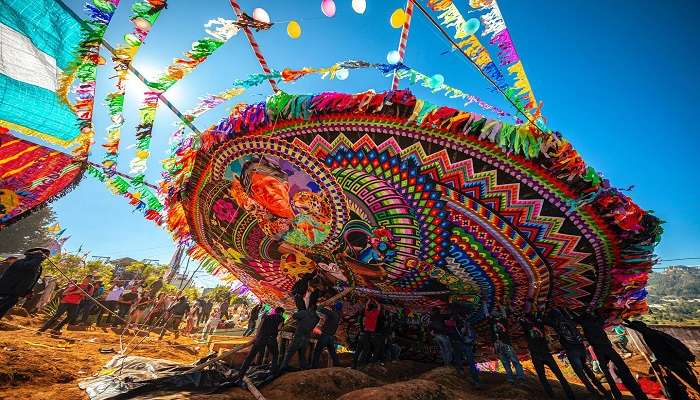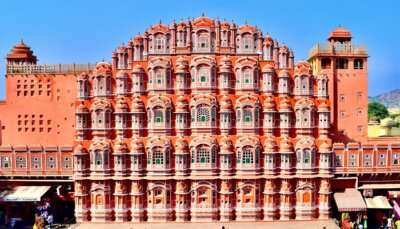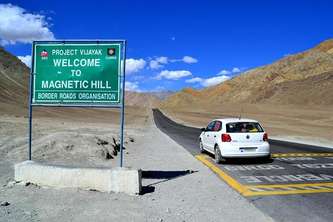Visit Guatemala Kite Festival: Celebration Of Family & Love

Are you ready to see some of the biggest kites you will ever see? Organised on the first of November each year, the Guatemala Kite Festival is a fascinating melange of tradition and art. Celebrated every year on All Saints Day, with this festival the Guatemalans commemorate the lives of their ancestors, saints, and all souls that have passed to the other realm. Most Latin American countries celebrate Dia de Los Muertos or Day of the Dead; in Guatemala, the day is an occasion for cheer, celebration, and remembrance. See creativity and Mayan heritage on full display with vibrant kites made out of traditional patchwork textiles & papers soaring the skies.
The Tradition of Kite Flying

The Kite Festival is one of Guatemala’s most unique & famous festivals. Celebrated annually in two villages – Sumpango and Santiago Sacatepéquez, giant kites up to 2.5 meters in diameter are flown during the festival. The festival is celebrated on the Day of the Dead which is also the All Saints Day or All Soul’s Day, pointing to the amalgamation of the Indigenous Mayan and Spanish cultures. The pagan ritual of kite flying and the ritual of remembering your loved ones and ancestors who passed away was omnipresent in Aztec, Incan and Mayan civilizations. The present inhabitants of the continent however are Mestizos or mixed-race people tracing their ancestry to both Native Indians and the Spanish and European colonisers. In this way, hybridity and diversity are celebrated, and pagan as well as Christian traditions are observed side by side.
The ritual of kite-flying dates back to more than 3000 years ago. Kites are believed to be a thread between this world and the next one. If the sky is a map of the other world, then kites are supposed to guide you to the souls of your ancestors. This way kites are symbols of connection and a way of honouring and thanking the previous generations and the saints for their lives and sacrifices. People from the town gather at town squares, football fields or the cemetery. They paint the graves of their relatives and have a meal there as a symbolic gesture of feeding the ancestors as well. With great aplomb, the kites are displayed and flown, competitions are held and winners are awarded with prizes. Kites that are the most creative, graceful & intricate and those with the longest flights are rewarded. The Guatemala Kite Festival is thus a beautiful ceremony unlike any other.
Also Read: International Kite Festival In Gujarat
Kites As Storytelling

The kites are not just decorative items, they are also important cultural symbols tied to Mayan identity and heritage. Participants and artists spend months crafting perfect eye-catching kites that can sometimes be up to 30 feet tall. Quilting and patchworking these kites is a generational activity passed down the family line. Sometimes the entire family comes together to source bamboo frames, beautiful textiles, and other materials for the kites, sewing and embroidering them, creating patterns of stitches and knots. The kites often tell ancestral stories of the family line and mythological stories, folk tales and legends also make an appearance on the kites.
Each family, village and town have their own patent style and way of making these kites which are no less than masterpieces. Nature and animals like shapes of peacocks, roosters, owls and butterflies are regular motifs. It is also not uncommon to see people use kites as a medium for political and social messages promoting women’s empowerment, children’s welfare, animal rights, and protests against government oppression, and climate change. No part of the kite-making process uses synthetic materials, even the glue used to bind everything together is made from organically sourced materials. The kites represent a collective sense of self and identity. Thousands of tourists from around the world visit annually to see this magic happen at the Guatemala Kite Festival.
Fiambre – Hearty Food For The Deceased

A food that is traditionally prepared and communally enjoyed on the El Dia de los Muertos, the Day of the Dead, is Fiambre. It is an iconic Guatemalan dish consisting of up to 50 ingredients cooked specifically on this day – a wholesome salad of sorts containing a variety of veggies and meats like pickled onions, beets, corn, Brussel sprouts, olives, cheese, chicken, sausages etc. The dish has a different recipe and taste in every household and varies greatly depending on family traditions and preferences. The two main variants are – Fiambre Blanco (without beets) and Fiambre Rojo (which contains beets).
The entire family eats the meal together in the cemetery and plates are laid out for deceased family members and ancestors. More delicious food that is prepared for All Saints Day includes Tamales, Ayute en Dulce (sweet potato in milk), and sweets like buñuelos & molletes. As the sun sets, music, singing and dancing ensue and people drink Horchata & Atol de Elote and celebrate life. Visitors to the Guatemala Kite Festival would be amiss if they didn’t join in the celebrations at the festival grounds and shop or try festival food.
Related Post: Brazil Festivals
Sumpango

Sumpango is one of the two towns where the Festival de Barriletes Gigantes or the Giant Kite Festival is celebrated. It is one of the smaller towns in the country with a population of over 48,000 people, which swells to a whopping 100,000 during the festival. Expect volcanic mountains in the background, rivers & lakes flowing through the landscape, windy days and dusty hills with jubilant crowds shouting cries of joy “Arrrriba!” whenever the giant kites finally take off.
You will see people exchanging food and sweets with family, friends and neighbours, vendors selling paper kites and street food, and flowery decorations made out of sunny marigolds considered Flor de Muertos or flower of the dead. When in Sumpango for the Guatemala Kite Festival, do not forget to also visit Acatenango Volcano and Lake Atitlán both of which are located at a close distance. The views of the countryside from the top of Acatenango are breathtaking and Atitlán is the biggest and deepest crater lake in the world.
Santiago Sacatepéquez

Santiago Sacatepéquez is another town in Guatemala located not far from Sumpango where the Guatemala Kite festival is celebrated on the first of November each year. The town and the festivities are a bit smaller than Sumpango but the spirit is just as bright and the kites just as big. If you want lesser crowds visit Santiago Sacatepéquez instead. Nestled in the heart of Guatemala, this town is a place full of natural beauty, ancient ruins and traditional Central American cuisine.
Senderos Alux Ecological Park is an attraction located near Santiago and contains a playground with giant swings, natural slides, bridges, a picnic area with Barbeque pits, an ecological theatre, camping grounds, waterfalls, and a museum. Other places of interest in Santiago include La Mano Gigante Hobbitenango, Parque Ecológico Florencia, and Aldea Pachalí. Tourists visiting the Guatemala Kite Festival can easily find accommodation in hotels and homestays and can visit the local cafes and restaurants for delicious local food.
Related Post: Argentina Festivals
How To Reach The Guatemala Kite Festival

By Air: The nearest airport to Sumpango is the Guatemala City (GUA) International Airport in Guatemala City. It is one of the two international airports located in the country. Mundo Maya International Airport is located on the other end of the country, about 7.5 hours away by car. If you intend to do a country-wide exploration, you can take either of the airports. But if you’re visiting solely for the Guatemala Kite Festival, make sure to reach Guatemala City, the capital of Guatemala, which makes for a less than 2-hour journey to Sumpango and Santiago Sacatepéquez. You can take shuttles and taxis to reach the towns. Flying from India can take up to 20-26 hours as Guatemala is one of the farthest countries from India.
Tips For Travellers To Guatemala Kite Festival
-
- Expect crowds at the festival grounds, squeezed among the people and standing in queues.
- The festival is free of cost, so beware of people asking for entrance fees or selling tickets.
- Delicious South American food is easy to find, and you’ll easily spot street vendors. However, make sure you don’t consume any allergens you don’t want to ingest.
- Enrolling early in the morning is an excellent way to avoid traffic jams and crowds. It is also a quiet time to observe the proceedings in a tranquil environment.
- November is the beginning of the dry season after the rains recede, so it can be quite hot and sunny outside. Remember to carry sunscreen, sun hats, and glasses.
- You will find yourself standing still and walking quite a bit, so wear comfortable shoes.
- Don’t forget to bring a camera to capture a snapshot of the day. All the kites are way too magnificent not to click them for remembrance.
You May Also Like To Read: Mexican Festivals
All set to begin your journey to the Kite Festival of Sumpango, Guatemala? Witness the grand celebration of festivities with zeal and happiness. The traditional food, giant kites, thrilling music, and festively decorated cemeteries make for memories that will last a lifetime. Make sure you visit during the first of November to experience the famous festivals in Guatemala and enjoy the beauty, culture, and hospitality the towns of Sumpango and Santiago Sacatepéquez offer. Plan your trip to South America to see how the Day of the Dead is celebrated in different Latin American countries.
For our editorial codes of conduct and copyright disclaimer, please click here.
Cover Image Source : Facebook
Frequently Asked Questions About Guatemala Kite Festival
What is the Guatemala Kite Festival?
Observed on the first of November, it is a celebration of the legacy of ancestors who passed away and Christian saints and their sacrifices. Guatemalans celebrate the Day of the Dead by cooking Fiambre and flying giant kites which are handcrafted over months.
Why do Guatemalans fly kites on the first of November?
It is believed that kites are a connecting thread between our realm and the next one where all the deceased souls have passed. Guatemala Kite Festival facts include that the kites are cultural symbols tied to Mayan identity and are prepared as a labour of love and thanksgiving to the ancestors.
Where is the biggest kite festival in the world?
The biggest kite festival in the world is the Weifang International Kite Festival in China. Other significant kite festivals are - Guatemala Kite Festival, Uttarayan Kite Festival in India, Festival of the Winds Sydney, and Bali Kite Festival.
What is the history of the kite flying festival?
The festival started more than 3000 years ago. It was believed that the flying kites rid the area of bad spirits and hauntings. The guatemalan culture thinks it disrespectful to mourn the dead, and thus they celebrate the Day of the Dead by flying giant colourful kites.
Do Guatemalans fly kites to honour their dead?
Yes, kite flying is a way of feeling connecting, offering prayers and honouring the deceased family members and ancestors in Guatemalan culture. They also paint the gravestones in vibrant colours, decorate the cemetery and shrines with sunny marigold flowers, and have fiambre together while leaving out plates for the ancestors as well.
People Also Read:
Jaipur Kite Festival Louisiana Pecan Festival Niagara Falls Festival Of Lights

Abhay Kumar is a graduate of English Literature. Writing is both his hobby and his passion. He writes academic research articles as well as poetry and short fiction. He loves reading science fiction, fantasy, literary fiction, and translated fiction. He also loves traveling and writing about himself in the third person.











